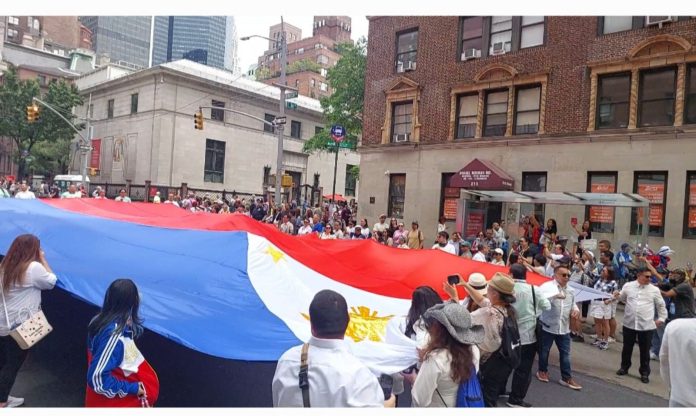A huge Philippine flag, measuring 25 by 50 feet, was a highlight of the parade celebrating the 126th Independence Day on Madison Avenue in Midtown Manhattan.
Considered the world’s largest celebration outside Manila, this year’s parade took place on June 2, 2024, as it is traditionally held on the first Sunday of June.
The event featured approximately 135 floats, organizations, and marching bands, some traveling from the Philippines. The parade spanned 10 blocks, from 38th Street to 27th Street on Madison Avenue, under the theme “Preserving Our Filipino Culture and Heritage to Unite Generations.”
Now in its 34th year, the event is a significant occasion for many Filipino Americans, aiming to reconnect them with their roots and heritage while commemorating the Philippine Declaration of Independence from Spain in June 1898.
According to an ethnogeriatrics study by Stanford Medicine, citing the 2022 American Community Survey by the United States Census Bureau, Filipino Americans (alone or in combination with other races) comprise merely 1% of the total U.S. population. However, they are the third largest Asian American group after Chinese and Indian Americans.
Filipino Americans are widely dispersed across the United States. California hosts the largest population, followed by Hawaii, Nevada, Texas, Illinois, New York, New Jersey, Washington State, and Virginia. The study also noted that between 1986 and 2006, the number of Filipino immigrants tripled, making them the second-largest immigrant group in the U.S. after Mexicans. About one-quarter of Filipino Americans reside in California.
Filipino households rank in the top 10 for multi-generational living among Asian American families.
Attendees included Assemblymember Steven Raga, the first-ever Filipino American elected state official. “We’re not only celebrating our heritage but also our ongoing contributions to the cultural fabric of this great state,” Raga said in an interview.
On June 5, 1898, President Emilio Aguinaldo issued the 21-page Acta de la Proclamacion de la Independencia del Pueblo Filipino from his house in Cavite, proclaiming June 12, 1898, as Independence Day. The Philippine flag was officially unfurled for the first time at about 4:30 p.m., accompanied by the Marcha Nacional Filipina performed by the San Francisco de Malabon band.
The proclamation was endorsed by 190 municipal presidents from the 16 provinces under revolutionary control on August 1, 1898, at Bacoor, and was officially ratified on September 29, 1898, by the Malolos Congress.
“This year’s theme pays tribute to the diversity of cultures and traditions that constitute our great nation, and highlights the importance of unity and respect for one another,” stated Arman David, president of the Philippine Independence Day Council Inc.
I saw groups performing local festivals like the Kuyamis Festival from Misamis Oriental, named after the Subanen word for a variety of sweet coconut found in the province, which is also the origin of the province’s name.
Groups from my alma mater, led by the University of the Philippines Alumni Association in America (UPAAA), founded in 1981 in New Jersey, also participated. Their primary goal is to unite alumni groups in America and support the UP System as the national center for academic excellence, freedom, and service. I encouraged them to perform the “UPFight” cheer in support of the UP Fighting Maroons.
Activist groups, including Bayan USA, Malaya USA, and Anakbayan, joined the march with placards bearing messages such as “West Philippine Sea, Atin ito,” “The Philippines is not for sale,” “Filipino workers unite,” “Honor our history of struggle,” “Fight for higher wages and better working conditions,” and “Junk labor export policy.”
Supporters of Vice President Sara Duterte from the MAISUG group followed, carrying placards demanding “voluntary drug testing for PBBM,” “rejection of bureaucratic corruption,” and “transparency and accountability.”
The street fair featured Filipino foods like barbecue, balut, halo-halo, lechon, sorbetes, fishball, and sisig.
Another celebration is scheduled for June 9, 2024, in Louisiana, where one of the first Filipino settlements in the United States was established by seafarers who arrived as navigators on Spanish ships during the Galleon trade, seeking to escape the harsh and abusive conditions.
Atty. Dennis R. Gorecho heads the Seafarers’ Division of the Sapalo Velez Bundang Bulilan Law Offices. For comments, e-mail [email protected], or call 09175025808 or 09088665786.









